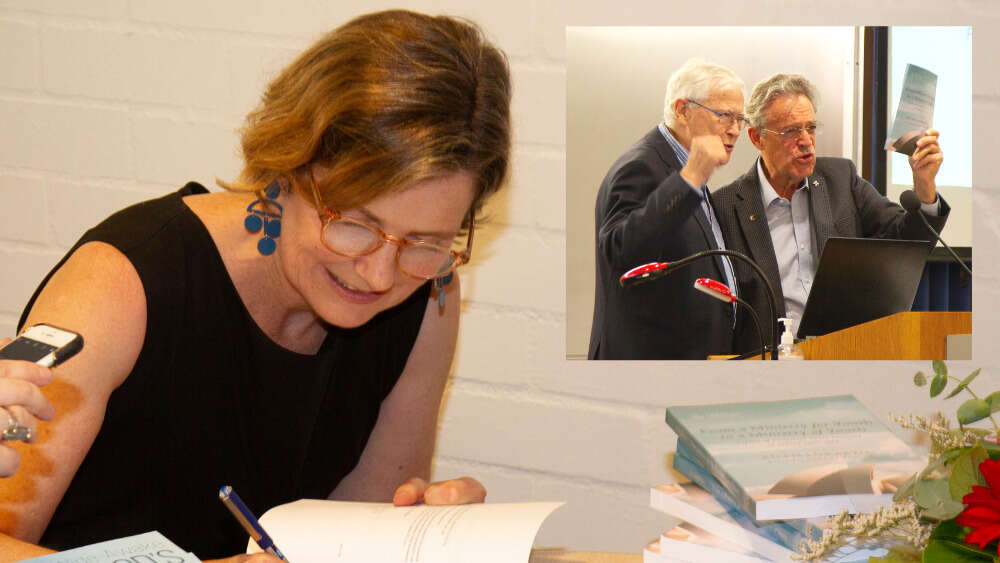“I’ve really fallen down the rabbit hole tonight,” I text my friend. “This is the most Anglican event I’ve ever been to!”
When I tell her that I’m at Moore College, the Sydney Anglican theological college, she replies with a laughing emoji. She is herself a Sydney Anglican and knows exactly how different all this is to my usual world.
I’m here for a book launch at the least Newtownish location in the whole of Newtown, which is the suburb I live in in Sydney’s alternative Inner West.
I might be on the distinctive and wildly diverse King Street, but I’m a long way from home.
I find my way past a rather intimidating wall of stern men’s portraits and into the lecture theatre, where I find exactly two faces I know – Michael Jensen and Megan Powell du Toit, the hosts of Eternity podcast With All Due Respect. I send the aforementioned text to my friend and settle in for the launch of From a Ministry for Youth to a Ministry of Youth: Aspects of Protestant Youth Ministry in Sydney 1930-1959 – a new book by Ruth Lukabyo (who everyone keeps telling me is lovely).
Powell du Toit is introduced and offers a few words on behalf of the publisher, the Australian College of Theology (ACT). They are delighted to be publishing Lukabyo’s book under their ‘Monograph Series,’ especially because both youth ministry and evangelicalism in Australia, as Powell du Toit notes, are under-researched areas.
“Mercifully jargon free” – Stuart Piggin
The evening continues and I discover there are at least two other people here whose names I am very familiar with, and they are launching the book together.
The first is highly-respected evangelical historian and author Stuart Piggin, who co-wrote Attending to the National Soul with Robert D. Linder – an award-winning, history of evangelicalism in Australia.
Piggin speaks about the rave reviews Lukabyo received from the American examiner of her PhD thesis – now published in the book being launched. He stresses how very well written it is, describing it as “mercifully jargon free.” He reads some of it aloud to make his point. I’m impressed.
Piggin reveals that reading Lukabyo’s work provoked an “uh-oh” response in him. It alerted him to the important role youth ministry played in the history of evangelicalism in Australia – which he himself had underestimated.
But From a Ministry for Youth to a Ministry of Youth is also an “a-ha” book, he says. Lukabyo’s insights see her adding a fourth historical category – age – to the “straight jacket” of race, gender and class which constrains most historians, he says.
“Clearly we must include more about youth ministries in our histories of evangelicalism,” says Piggin. “Lukabyo shows us why and how to do it.”
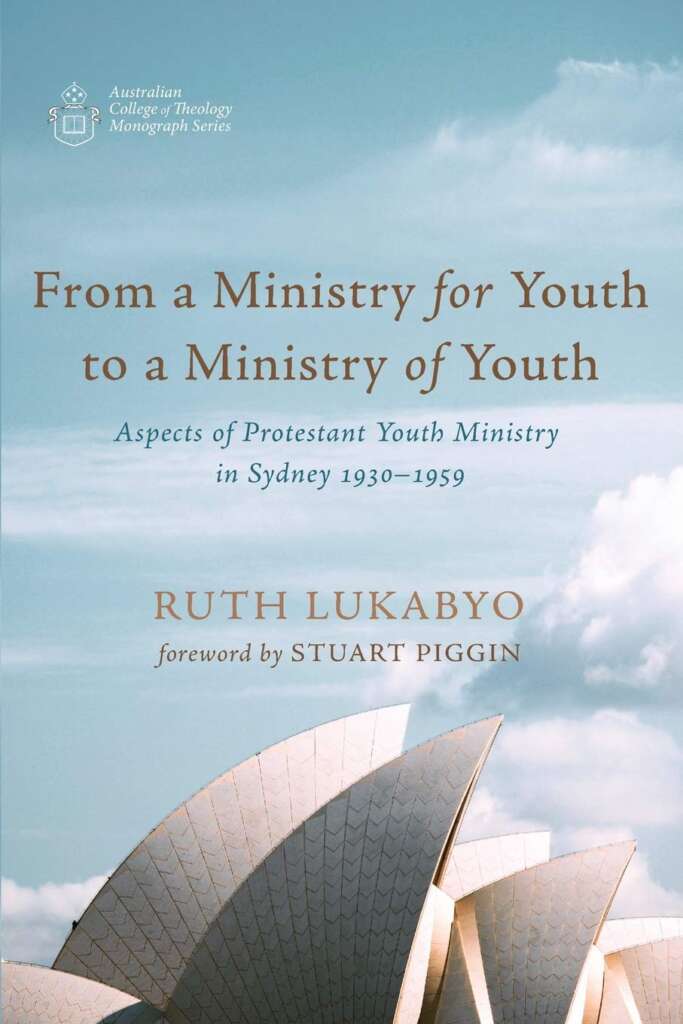 And the key feature of these successful youth ministries which emerge from the pages of the book? The collaboration of the sexes, he says. Ah! Now this interests me, as I think of the young couple who pastor the youth at my own church.
And the key feature of these successful youth ministries which emerge from the pages of the book? The collaboration of the sexes, he says. Ah! Now this interests me, as I think of the young couple who pastor the youth at my own church.
“I have lived it. It speaks the truth. As I read it, it revealed me to myself.” – Peter Jensen
Next up is former Sydney Anglican Archbishop Peter Jensen – a name I know very well.
Like Piggin, Jensen has high praise for Lukabyo’s understated work as a historian with the book’s unpretentious title revealing “God at work”.
“We see the perennial in the particular. The cast is small and limited … but that is the point,” Jensen asserts. “Naive beginners were entrusted with the gospel with the grace of God and the fellowship of his people.”
He also confesses that his speech will likely be “egocentric” because, as a reader, the book tells the story of his life as an evangelical youth.
“I have lived it. It speaks the truth. As I read it, it revealed me to myself,” Jensen says, describing this a “testimony to the authenticity of this book.”
But Lukabayo’s book doesn’t merely ring true to Jensen, he says. It actually “fills out” his understanding of his experiences as a youth and “explains” them “back to himself.”
Jensen reflects that evangelicals like himself benefitted from the work of youth leaders between the 1930 and 1959 – the period Lukabayo covers and shows youth ministry transformed from being for youth to being run by youth. And they benefitted so greatly that they “assumed it was a normality, not an innovation” to have these young leaders.
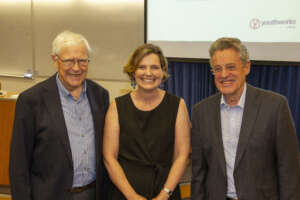
Image: Jimmy Knight
Lukabyo’s focus appears to have revealed the roots of Jensen’s own conversion and discipleship to him – and he’s clearly inspired.
While her study culminates in the 1959 Billy Graham crusades when so many young people made decisions to accept Christ – including Jensen himself – he stresses that Lukabyo’s insights cause “us to think missionally about the present.”
“Lukabyo looks forward and asks “What now?’” Jensen notes. And in doing so, she encourages us to “take what is perennially so and apply it to the particular circumstances we find ourselves in.”
“Older Christians supported them and guided them, but they did not take over. They stood beside them in partnership.” – Ruth Lukabyo
Though I am glad that the evening has turned to talking about youth ministry happening now, this nostalgic celebration of youthful Christianity has also sent me back down memory lane thinking about my own youth leaders. How can I not? This lot are contagious.
I’m struck by what a particularly strong sense of history they have here at Lukabyo’s launch. My church tribe also love to recount our story of beginning in Australia, but we’ve only got 40-odd years to talk about. The story being told in this room dates back all the way to colonisation, really.
Yes, there are obvious barriers to an outsider making sense of the evening’s proceedings. A bajillion acronyms are assumed knowledge, for one thing. But after a few years of working at Eternity, I’ve learned to recognise certain acronyms and references as Sydney Anglican markers. There’s the Billy Graham’s crusades, school scripture classes (aka SRE), Evangelical Union (EU) leadership, Crusaders, ICF (not sure what that one stands for), IVF (a different IVF to the one you’re thinking of!), Youthworks (their youth training program), Beach Mission, and countless references to missionaries who, for some reason, always seem to be from Tanzania.
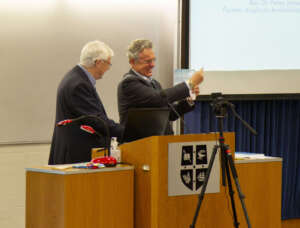
Image: Jimmy Knight
The evening may well be “insider baseball” but I enjoy watching these friends relish in the shared history that endows them with a sense of belonging. The term “evangelical” is mentioned often and is evidently claimed with great pride, which is kind of lovely after several months of my reading of articles about American politics where it’s basically synonymous with “conservative Christian.”
The same tribalism that is often critiqued is also revealed to be grounding. These Sydney Anglicans have roots that go down deep and I can imagine they help to hold one steadfast when the winds of change sweep through.
Jensen invites Piggin back up to join him with a disclaimer that neither of them are quite sure how to launch a book – and, as Piggin holds From a Ministry for Youth to a Ministry of Youth high, together they declare it launched.
Then the woman of the evening, Ruth Lukabyo, takes the microphone.
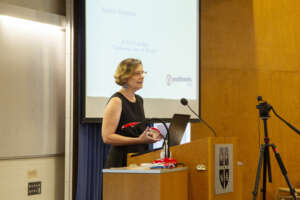
Image: Jimmy Knight
Lukabyo tells everyone she’d had to cancel her 50th birthday party plans earlier in the year due to COVID, so this book launch feels like its replacement. She warmly thanks Piggin and Jensen for their support over the years of her study and writing, describing them as “Fathers in the Lord” whom she loves very much.
Her hopes for the book, she says, are that it might be stimulating and useful, especially for those who are working in ministry to and with youth.
“I think we need to remember that youth are not just trainee Christians, but they are Christians.” – Ruth Lukabyo
Lukabyo says that a key lesson she took from her research was that today we often underestimate the ministry of young people. As evidence, she points to the myriad of organisations started in the early 1930s.
“In all these organisations, the young people stepped up to take the leadership and ownership. They gave the talks, gave their testimonies, invited friends, organised activities, organised camps, and shared their faith with friends.”
“Older Christians supported them and guided them, but they did not take over. They stood beside them in partnership,” Lukabyo explains.
“I think we need to remember that youth are not just trainee Christians, but they are Christians – they have the spirit of God in them. Not the church of tomorrow but the church of today.”
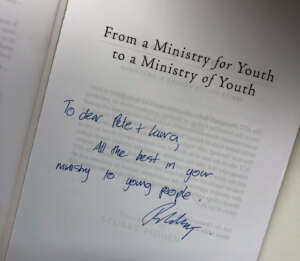
Afterwards, I line up to buy Lukabyo’s history of youth leadership in Australia for the youth pastors of my own church.
“To dear Pete and Laura, All the best in your ministry to young people,” she inscribes on the title page and signs it.
I’m excited to pass this book that traces and celebrates the history of youth leadership in Australia on to the couple I know who follow in those footsteps today. If they can just get past the acronyms, I reckon they are going to love it.
